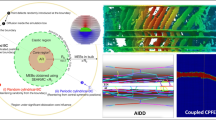Abstract
Diffuse scattering is a probe of the local correlations in a crystal, whereas Bragg peaks are descriptive of the average long-range ordering. The long-range average is the result of numerous local configurations the population of which cannot be determined from the Bragg peaks. Diffuse scattering can examine this population. This is particularly the case when making use of the three-dimensional distribution of diffuse scattering from single crystals. However, diffuse scattering is very weak and broad and is often of similar intensity to the experimental background, which makes data collection demanding. Disorder can also take many forms and local configurations are not constrained by the average crystallographic symmetry. Here, three approaches to the modeling of diffuse scattering from molecular crystals will be discussed. All three approaches are based on a Monte Carlo (MC) simulation. As an example, the modeling of neutron diffuse scattering from para-terphenyl (PTP, C18H14) will be described.












Similar content being viewed by others
References
T.R. Welberry: Diffuse X-Ray Scattering and Models of Disorder, Oxford University Press, Oxford, United Kingdom, 2004.
T.R. Welberry, D.J. Goossens, W.I.F. David, M.J. Gutmann, M.J. Bull, and A.P. Heerdegen: J. Appl. Crystallogr., 2003, vol. 36, pp. 1440–47.
D.A. Keen, M.J. Harris, and W.I.F. David: Physica B, 1998, vols. 241–243, pp. 201–03.
D. Hohlwein, J.-U. Hoffmann, and R. Schneider: Phys. Rev. B, 2003, vol. 68, pp. 140408-1–140408-4.
W. Schweika and P. Boni: Physica B, 2001, vol. 297, pp. 155–59.
W. Schweika: Disordered Alloys: Diffuse Scattering and Monte Carlo Simulations, Springer Verlag, New York, NY, 1998.
M.A. Estermann and W. Steurer: Phase Transitions, 1998, vol. 67, pp. 165–95.
S. Scheidegger, M.A. Estermann, and W. Steurer: J. Appl. Crystallogr., 2000, vol. 33, pp. 35–48.
D.A. Keen, M.J. Gutmann, and C.C. Wilson: J. Appl. Crystallogr., 2006, vol. 39, pp. 714–22.
G.M. Day, W.D.S. Motherwell, H.L. Ammon, S.X.M. Boerrigter, R.G.D. Valle, E. Venuti, A. Dzyabchenko, J.D. Dunitz, B. Schweizer, B.P. van Eijck, P. Erk, J.C. Facelli, V.E. Bazterra, M.B. Ferraro, D.W.M. Hofmann, F.J.J. Leusen, C. Liang, C.C. Pantelides, P.G. Karamertzanis, S.L. Price, T.C. Lewis, H. Nowell, A. Torrisi, H.A. Scheraga, Y.A. Arnautova, M.U. Schmidt, and P. Verwer: Acta Crystallogr., 2005, vol. B61, pp. 511–27.
B.D. Butler and T.R. Welberry: J. Appl. Crystallogr., 1992, vol. 25, pp. 391–99.
Th. Proffen and R.B. Neder: J. Appl. Crystallogr., 1997, vol. 30, pp.171–75.
W.J. Hehre, L. Radom, P.R. Schleyer, and J.A. Pople: Ab Initio Molecular Orbital Theory, John Wiley, New York, NY, 1986.
I. Tanaka, F. Iwasaki, and A. Aihara: Acta Crystallogr., 1974, vol. B30, pp. 1546–49.
N. Metropolis, A.W. Rosenbluth, M.N. Rosenbluth, A.H. Teller, and E. Teller: J. Chem. Phys., 1953, vol. 21, pp. 1087–92.
L.H. Thomas, T.R. Welberry, D.J. Goossens, A.P. Heerdegen, M.J. Gutmann, S.J. Teat, C.C. Wilson, P.L. Lee, and J.M. Cole: Acta Crystallogr., 2007, vol. B63, pp. 663–73.
H.M. Rietveld, E.N. Maslen, and C.J.B. Clews: Acta Crystallogr., 1970, vol. B26, pp. 693–706.
P.J.-L. Baudour, Y. Délugeard, and H. Cailleau: Acta Crystallogr., 1976, vol. B32, pp. 150–54.
P.J.-L. Baudour and G.-P. Charbonneau: Acta Crystallogr., 1974, vol. B30, pp. 1379–79.
P.J.-L. Baudour, H. Cailleau, and W.B. Yelon: Acta Crystallogr., 1977, vol. B33, pp. 1773–80.
D.J. Goossens, A.G. Beasley, T.R. Welberry, M.J. Gutmann, and R.O. Piltz: J. Phys.: Condens. Matter, 2009, vol. 21, p. 124204-1–124204-10.
D.J. Goossens and M.J. Gutmann: Phys. Rev. Lett., 2009, vol. 102, pp. 015505-1–015505-4.
T.R. Welberry and S.L. Mair: J. Phys. C: Solid State Phys., 1987, vol. 20, pp. 4773–81.
R.E. Lechner, B. Toudic, and H. Cailleau: J. Phys. C: Solid State Phys., 1984, vol. 17, pp. 405–20.
Acknowledgments
The authors greatly appreciate the financial support of the Australian Research Council (The Commonwealth of Australia, Canberra, ACT, Australia), the Australian Synchrotron Research Program (Clayton, VIC, Australia) the Access to Major Research Facilities Program (Australian Nuclear Science and Technology Organisation, Menai, NSW, Australia), the Australian Partnership for Advanced Computing (The Australian National University, Canberra, ACT, Australia), and the Australian Institute for Nuclear Science and Engineering (Grant No. AINGR05199, Menai, NSW, Australia). The authors also thank A.P. Heerdegen for contributions to many aspects of this work, M.J. Gutmann for contributions to the PTP study, and L.H. Thomas for contributions to the PCNB study.
Author information
Authors and Affiliations
Corresponding author
Additional information
This article is based on a presentation given in the symposium entitled “Neutron and X-Ray Studies for Probing Materials Behavior,” which occurred during the TMS Spring Meeting in New Orleans, LA, March 9–13, 2008, under the auspices of the National Science Foundation, TMS, the TMS Structural Materials Division, and the TMS Advanced Characterization, Testing, and Simulation Committee.
An erratum to this article can be found at http://dx.doi.org/10.1007/s11661-009-9972-4
Rights and permissions
About this article
Cite this article
Goossens, D., Welberry, T. Approaches to Modeling Diffuse Scattering from Molecular Crystals: Para-Terphenyl (C18H14). Metall Mater Trans A 41, 1119–1129 (2010). https://doi.org/10.1007/s11661-009-9897-y
Published:
Issue Date:
DOI: https://doi.org/10.1007/s11661-009-9897-y




